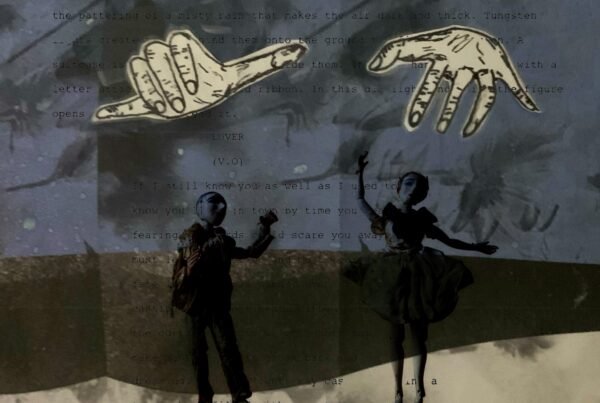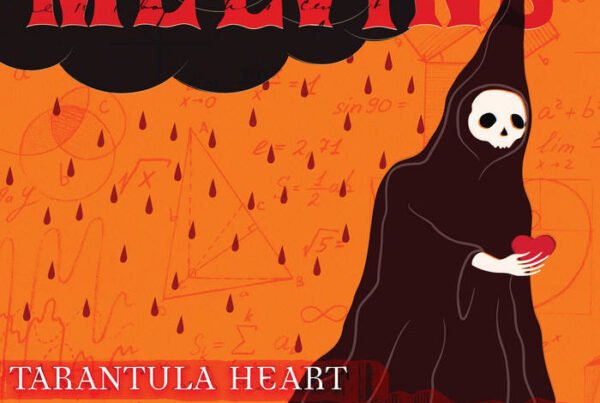The turmoil ignites itself by means of elongated, disharmonious, and phasing noisy drones, acting as vague boundaries for the rhythmic percussion existing outside the parameters of standard time signatures and tempos, as the heartfelt but unintelligible vocals steer the onslaught forward. You’re bound to a seat in the front row at an old, partly burnt-down theatre, wondering in awe at the spectacle unfolding before your eyes dried out by being so fixated to what’s happening that you forgot to blink ever since the first seconds of “Masse critique” kicked in, paving the way for this unexpected and earthmoving performance titled Rien ne suffit, served by Plebeian Grandstand, a group shrouded in a fog of secrecy and unexpectedness that appears in morphing figures somewhat akin to the mold of human beings.
Carried off by piercing noises and discerning screams echoing from the shadowed corners, the stage is split into two as lights go off on the left side, while the right is being occupied by the mirage of a massive, serpentine colossus slowly amassing its form amidst the scorched rubble and reeking smoke. “À droite du démiurge, à gauche du néant” demonstrates how vast emptiness and existence sought from chaos can coexist in an impermanent balance, while the soundtracking act in the middle draws influence equally from each side. The ominous, towering form hovers back and forth as the angular voices echoing from the center sink their teeth into your soul, crawling up and down your spine as an unsettling sense of dread takes over your mind. Petrified in astonishment, you see the writhing serpent eroding and descending back to the ruins it emerged from, as the darkness looming on the left extends its tentacle-esque margins, eventually obfuscating the stage during “Tropisme”.
As you get adjusted to the murk surrounding you, a single tear slithers down your cheek, leaving a tiny trail on your ash-stained skin. Unbelievably rapid strobe lights detonate on the stage, spewing forth a wave of pressure that washes over the auditorium, nearly breaking your neck as your head hits the back of your seat. The cut-up, violently flickering sight transforms your overwhelming dread into engulfing panic, but no matter how hard you try, you can’t move, nor can you direct your eyes away from the abstract tapestry pulsating in front of you. The performers twitch and judder in sync with the lights, and as you feel the invisible hand around your throat tightening its grasp, you see shadowy giants, three times the height of a man, seeping through the stained back wall of the platform.
The figures, all of them fully veiled but some saliently bereft of their heads, form a circle around the act, rotating in an accelerating pace until their edges blur together. You stare at the vortex and feel something breathing down your neck, unable to turn and see it for what it is; not that you’d really want to do so. “Angle mort” escalates and contracts in an alternating fashion, as a red beam breaks the formation made up of these horrid abominations, dissolving them in an instant. The strobes cease and shift into a sea of fiery brilliance presenting the stage in its most immaculate and intact condition, free of the debris and havoc that had replenished it. As everything comes to a halt, potent and abiding, dinning applause fills the theatre, the performance reaching its intermission.
As the applause goes on, a strange kind of warmth and relief settles in, although you’re fully aware you’re monitoring this ensuing spectacle all by yourself, alone. You can feel the presence of others and hear their subtly whispered commendations, but you can’t be sure whether they’re actually there or merely figments of your imagination. Regardless, the performance proceeds. Noisy swells slowly gather potency, as the one figure providing the narration for this audiovisual display murmurs at the black curtains draping the background throughout “Espoir nuit naufrage”, facing away from you in the spotlight. The more welcome emotions lose their vigour and turn to dust as the curtains are being drawn away, exposing a barren landscape stretching as far as the eye can see in lieu of the theatre’s back wall. The silent mutter endures through “Nous en sommes là”, and the atmosphere, wildly varying throughout the entirety of this spectacle, takes a callous turn. Harnessing sub-bass frequencies, the lights dim as the crackling noises appear once again.
Whatever shreds of haunting calm were left are flicked away as “Rien n’y fait” restores the cacophonous distress familiar from the first acts. The visions evoked through sound and projected at the world shown to you are palpable and fervent, packed with unrelenting chaos and firmly contained furious prowess, capable of introducing life to the drought, subduing the scape you’re gazing at. Roots grow into trees bearing poisonous fruits and rocks morph into mountains as clouds gather on the sky, glowing with the limpidity of a dozen suns. The still-pummeling aural sinew contrasts the Fata Morgana that, while it turns out to be brief, bears unforeseen beauty and significance. But as faith has it, everything starts to tarnish once again as the howling winds modulate into reverberating screams, and you start to tell apart an immense wave of claret mounting on the now grim horizon.
As the surge nears, the lights begin glinting to the tremoring pace of “Jouis, camarade”, the tall trees and ample mountains sink alike, the vibrant birds fall from the sky, the novel mammals drown regardless of their stampede, and eventually the outbreak reaches the perimeters of this sullen theatre. It washes in, but you’re unable to fear it, while still firmly lodged into your seat, wondering at the events summoned upon you. Fully submerged, you see the performance continuing on the stage as fleets of dead animals and wreckage float by. You cry, not out of fright but pure delight, as the current abates and the level of the crimson tide lowers for the ultimate segment, “Aube”. The showmen lose their shape as the minutes pass by, transmuting themselves into similar bodies as the ones that visited earlier on, only to evaporate and conjoin with the milieu, vanishing from plain sight right before the black curtains drop to conceal the stage, and the lights come on.
You are left alone in the ensuing silence, weeping, trying to comprehend the intimate and holistic, near unfathomable experience that Rien ne suffit offered you. Its constantly mutating appearance has left a permanent mark on your memory, and while you slowly come to terms with it, it evades all understanding for a long while. There you are, alone in the auditorium of Plebeian Grandstand‘s dismal theatre, stuck to your seat. As the lights go dim, you realise you’re caught in an endless loop, destined to live through this show of fascinating horrors over and over again. You realise you can’t escape from it, though you know you wouldn’t even if you could. And you smile in awe, waiting to live through it all once again.






